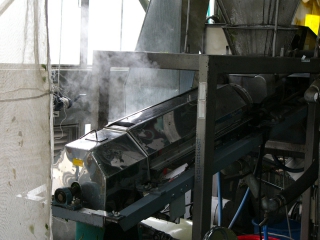Tea Processing Tencha (powdered green tea)

For tencha (powdered green tea), immediately after being picked, the tea leaves are steamed to stop oxidation (the majority of Japanese green tea processing starts in this manner).
![]()

This machine allows the freshly steamed tea leaves to cool. It is also known as a tea cooling machine.
![]()

Once steamed, the tea leaves are blown upwards using a strong wind. Once they fall back down, this process is repeated 4 additional times, each time blowing the tea leaves back upwards. As the leaves are blown about, they are transferred across 4 different rooms.
![]()

After exiting the tea leaf spreader, the tea leaves are placed into a tencha-ro (a special type of furnace for tencha) that measures approximately 10m in length. The tencha-ro is made of bricks in order to make use of radiant heat (it is not brick coloured as mortar has been applied to preserve the bricks).
![]()

At the tencha-ro entrance, a mesh-like conveyor belt that allows air flow is moving. Tea leaves are deposited on top of this mesh after leaving the tea leaf spreader. The tea leaves, still maintaining the shape they were picked in, enter the furnace.
![]()

Within the 10m furnace, the tea leaves make one and a half rounds moving slowly in order from the bottom tier to the top tier, and back to the middle tier. Tea leaves in the bottom tier are blown to the top tier by a fan (not pictured).
![]()

In order to separate the leaves from the stalks, a machine known as a winnower is used. Using wind power, the differently weighted leaves and stalks can be separated; the leaves will float, while the stalks will fall.
![]()

Tea stalks are harder to dry and require additional drying; this is done separately from tea leaves.
![]()

This is the unrefined form of tencha, known as aracha. The leaves and stalks undergo additional processing at a tea wholesaler. Processed tencha becomes maccha, whereas the stalks are processed into houji (roasted green) tea.
![]()